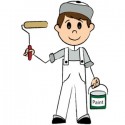Career Profile: Painters and Decorators

Type of Work
Painters and decorators apply paint, wallpaper and other finishes to interior and exterior surfaces of buildings and other structures.
Sources of Employment
Employment opportunities will come primarily from positions freed up by painters and decorators who retire, leave the trade or receive promotions to painting and decorating contractor or supervisor positions or, if they have the qualifications, to construction manager positions. Some opportunities will result from employment increase.
Labour Pool
Job opportunities will be available for the many experienced painters and decorators who are unemployed, for graduates with a Vocational Studies Diploma (DEP) in commercial and residential painting, and especially for people who meet the conditions for obtaining an apprentice certificate without having a diploma (see Training). It is possible to obtain a painter apprentice certificate issued by theCommission de la construction du Québec (CCQ) without completing a Vocational Studies Diploma in commercial and residential painting when there is a regional shortage. The proportion of new apprentices who do not have this diploma is very high. In fact, between 1998 and 2012, about 78% of new painter apprentices did not have this diploma. This situation seems strange considering the CCQ’s policy to encourage workers to take vocational training to access construction trades. It could be explained by the lack of interest in training among youth or a lack of places in vocational training schools. Furthermore, this occupation lends itself very well to on-the-job training combined with supervision by an experienced painter who passes his knowledge on to the apprentice.
Industries
According to census data, in 2006 about 75% of painters and decorators worked in the construction industry, most of them in building finishing work (65%), but also in residential building construction (8%). There were also significant numbers in the manufacturing sector (7%).
Employment Characteristics
According to census data, women held about 13% of the jobs in this occupation in 2006, a percentage that has been rising significantly since 1991 (7%). The annual average income data given in the “Characteristics” section of the “Statistics” ($29,538) should be used with caution. The data include only the 27% of painters and decorators who worked full time and full year in 2005. The average employment income for those who did not work full time and full-year was only $17,925.
Because of the tightening up of entry conditions for this trade, the level of education of roofers and shinglers improved greatly between 1991 and 2006, although it is still below that for all occupations. The proportion of painters and decorators with at least a post-secondary diploma rose from 30% to 54%, while the proportion of those who did not have at least a secondary school diploma dropped from 41% to 23%. Seasonal unemployment is relatively high. Thus, the average number of employment insurance claimants is three times higher from January to March than in August.
Education and Training
In Quebec, apprentice and journeyman certificates of competency from the Commission de la construction du Québec (CCQ) are required to work on construction sites. To obtain an apprentice painter certificate, you must:
– have a Diploma of Vocational Studies (DVS) in commercial and residential painting and a guarantee of 150 hours of work from an employer.
– in the event of a regional shortage, where CCQ data indicate that under 5% of apprentice certificate holders in a region are available, provide a guarantee of 150 hours of work, have taken a safety course, and meet the entry conditions for the commercial and residential painting course. Apprentices without a diploma are also required to participate in a training activity in order for their certificate to be renewed.
To become a journeyman, an apprentice must complete an apprenticeship period of 6,000 hours (including DVS training, if applicable) and pass the CCQ qualification exams. The certificate is automatically renewed each year if the holder has appeared on an employer’s monthly report in the 14 months preceding the renewal date. Otherwise, workers must renew their certificates.
For painter jobs not subject to the Decree for the construction industry, employers usually require a DVS in commercial and residential painting or an apprentice or journeyman certificate.
Training in tender estimating provided by school board employer services is an asset for self-employed workers and those seeking a promotion.
Red Seal certificate holders can work anywhere in Canada.





Leave a comment!